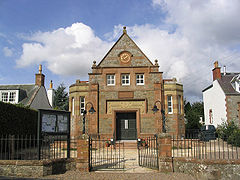Bowden, Scottish Borders
| Bowden | |
|---|---|
 Bowden Village Hall built 1896 |
|
| Bowden shown within the Scottish Borders | |
| Population | 223 |
| OS grid reference | NT555305 |
| Council area | |
| Lieutenancy area | |
| Country | Scotland |
| Sovereign state | United Kingdom |
| Post town | MELROSE |
| Postcode district | TD6 |
| Dialling code | 01896 |
| Police | Scottish |
| Fire | Scottish |
| Ambulance | Scottish |
| EU Parliament | Scotland |
| UK Parliament | |
| Scottish Parliament | |
Bowden is a village in the Roxburghshire area of the Scottish Borders, situated 3 miles (4.8 km) south of Melrose, 2 miles (3.2 km) west of Newtown St Boswells and tucked in the shadow of the Eildon Hills, Scotland.
In 1113, when King David I of Scotland granted lands to the monks of Selkirk, he also granted them the land at Bothandene (Bowden) and Hailiedene (Holydean). The charter was renewed in 1124 when the monks moved to Kelso, where they founded the maginificent Kelso Abbey. At the same time a religious establishment was founded at Bowden. The abbot of Kelso built a tower at Holydean which was destroyed in 1296. The tower was rebuilt and extended by Isabel Ker of Cessford and renamed Castle Holydean. The castle became the home of the Ker family, later the Dukes of Roxburghe, who lived there for two centuries before the castle was finally destroyed in 1760 by the 3rd Duke, John Ker. The Roxburghes moved to their new home, Floors Castle, in the early 18th century.
In 1531, Bowden village was granted the right to hold a market, the first non-burghal market in Scotland, and a market cross which still stands today was erected - such was the importance of the village in mediaeval times. The cross is now used as the parish war memorial.
The present Bowden Kirk was greatly enlarged in the 17th century, but parts of an older church are still evident. The church is unusual inasmuch as it has three bells, two of which are still in use. The third bell is contained inside the church and bears the inscription SOLI DEO GLORIA JOHN MEIKEL ME FECIT EDINBURGHII ANNO 1690, meaning "I was built by the grace of God at Edinburgh in 1690 by John Meikle". John Meikle was an eminent bell maker and tuner in 17th century Edinburgh. The old kirkyard contains many interesting gravestones and, under the east wing, a burial vault which contains 22 members of the Ker family, six of them Dukes of Roxburghe. The church is embellished with some wonderful stained glass windows including the Priest's Door, built at the old priest's doorway.
...
Wikipedia

